With a deep aroma and elegant flavor, Salmon Kasuzuke is a classic Japanese dish that‘s easy to make. In this traditional cooking method, we marinate the fish in sake lees and broil it to perfection. Impress your dinner guests with this standout dish!
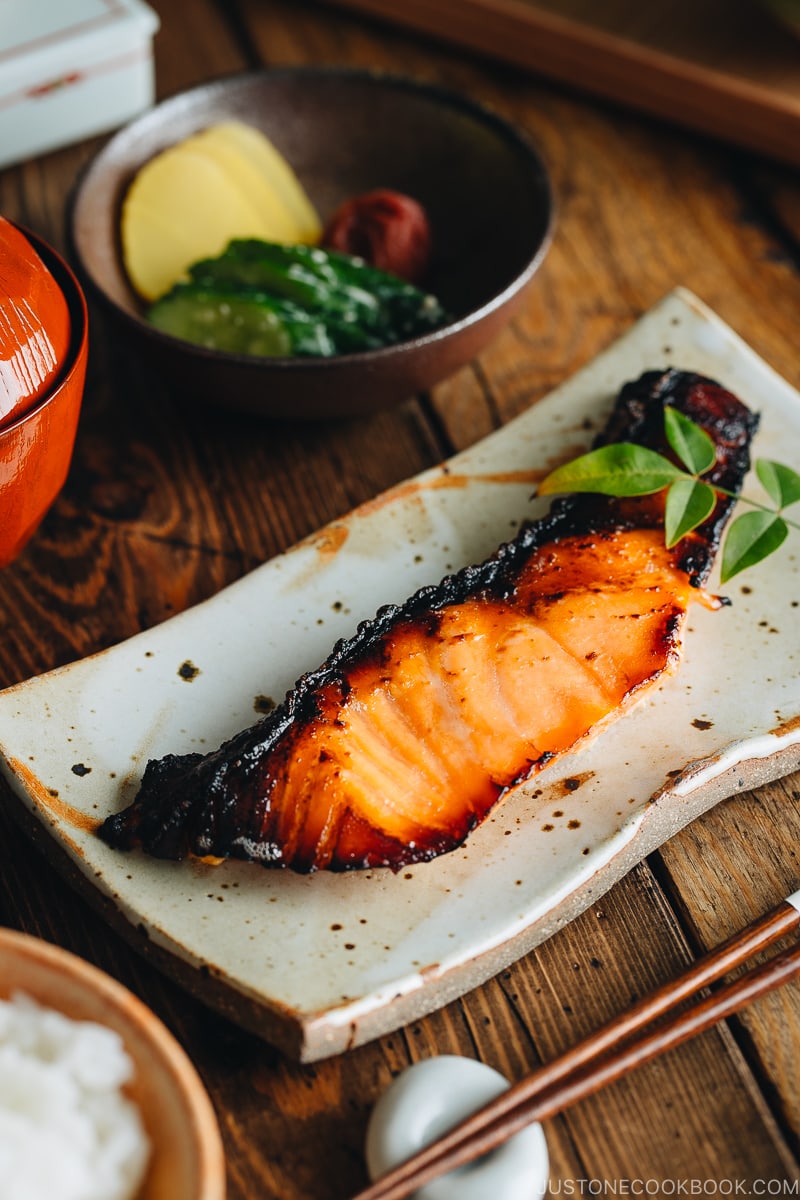
Do you eat fish regularly in your diet? While the options of fish in the US are somewhat limited compared to Japan, I try to incorporate fish routinely in our family meals. Fish provides high-quality protein and beneficial omega-3 fatty acids, so I am glad that my children enjoy eating it. Among the different choices, they love mackerel, salmon, and hamachi kama best.
In today’s recipe, I’ll show you my delicious Salmon Kasuzuke (鮭の粕漬け) using this traditional Japanese method of preparing fish. It preserves the nutrition of the salmon and accentuates the flavors wonderfully.
Table of Contents
What is Kasuzuke?
Salmon Kasuzuke is a classic Japanese dish where salmon is marinated in sake lees (sake kasu) and then grilled on the stovetop or broiled in the oven. The dish stands out with its uniquely sweet and alcoholic aroma.
Kasuzuke (粕漬け) means sake lees (kasu) and pickling/marinade (zuke). This cooking technique preserves ingredients and imparts complex flavors, and has been around since 1200 years ago.
If you are interested in learning more about kasuzuke in detail, please read my Tsukemono – Kasuzuke (Sake Lees Pickling) post. In today’s recipe, we use the sake lees marinade called kasudoko (粕床) to marinate the salmon.
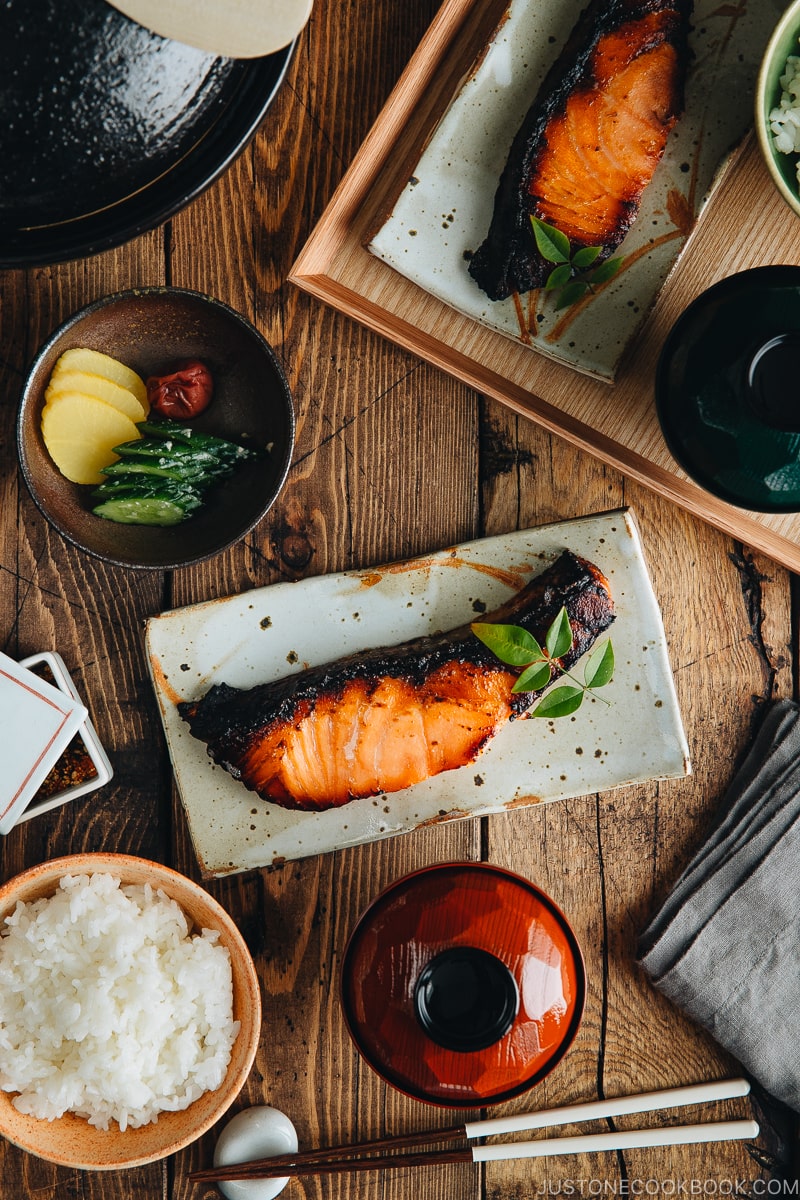
What are Sake Lees (Sake Kasu)?
Sake lees (sake kasu) are a byproduct of sake production left behind after the liquid is filtered from the fermented rice.
Sake lees are packed with nutrients like protein, carbohydrates, fiber, vitamins, organic acids, and minerals. They have health benefits to help people suffering from ailments like diabetes and high blood pressure. Sake lees are great for making your skin beautiful, too! Who doesn’t want that?
3 Reasons You’ll Love Salmon Kasuzuke
Kasuzuke… this unfamiliar Japanese word can be very intimidating. But I’m here to tell you 3 reasons why you should make this salmon dish.
1. Extremely easy to make
Despite its complex flavor, cooking salmon cannot be any more simple with this method. Check out the step-by-step instructions below, and then check how to make misodoko (the marinade). Very easy, right?
2. The kasudoko (sake lees marinade) lasts for 6 months!
The sake lees marinade that you put on the salmon is reusable and lasts up to 6 months! That means this marinade is always available in your fridge. All you need to do is to dunk the salmon fillets in the marinade and wait for 24 hours. Very budget-friendly too.
3. Great health benefits
Salmon is packed with omega-3 fatty acids which bring big health benefits. Think of extra protection for your brain, nerves, and eye development. As the body can’t make omega-3 fatty acids, the best way to obtain them is through the food we eat.
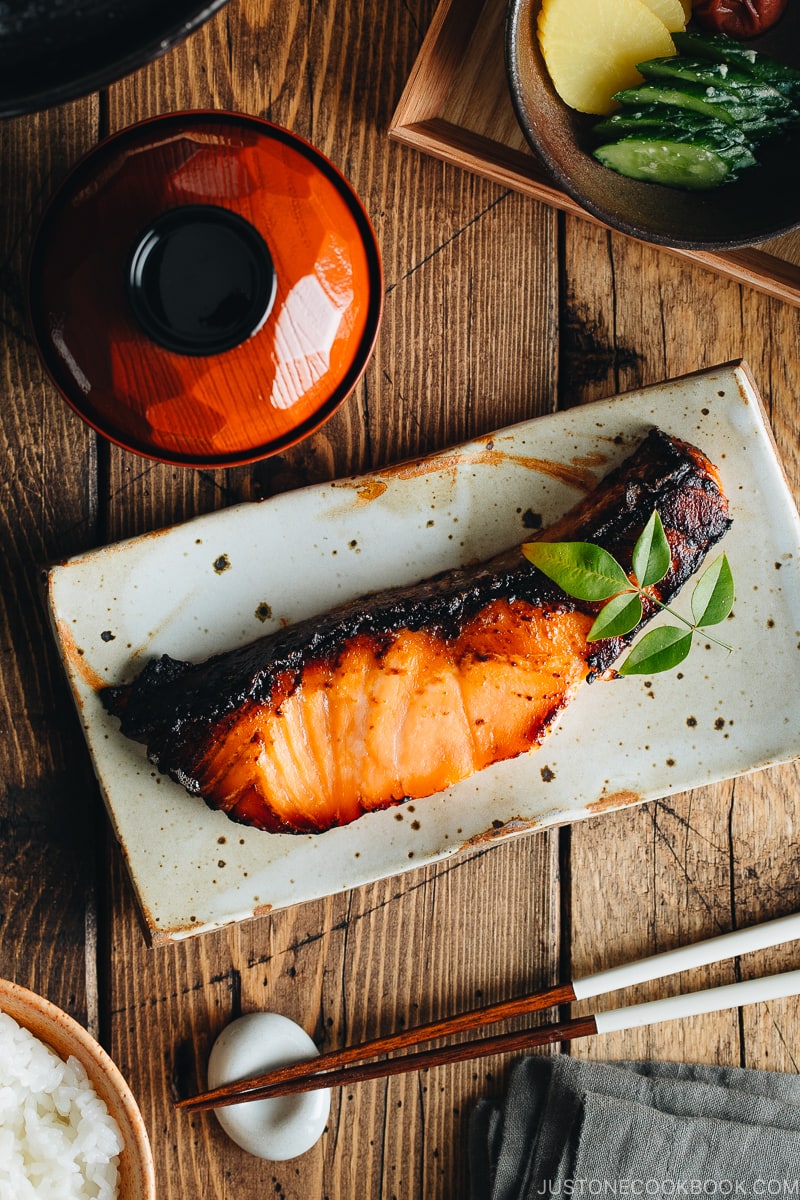
Ingredients for Salmon Kasuzuke
- skin-on salmon fillets – I use thin-cut salmon from a Japanese grocery store
- Diamond Crystal kosher salt – 2% of the salmon’s weight in salt
- homemade kasudoko – sake lees marinade; I make mine with white miso, sake or hon-mirin, sugar, and salt; see my Kasuzuke (Sake Lees Pickling) recipe for how to make it
How To Make Salmon Kasuzuke
- Sprinkle kosher salt on both sides of the salmon fillets and set aside for 30 minutes. Remove the excess moisture from the salmon with a paper towel.
- Place the salmon in the kasudoko and cover completely.
- Marinate for 6–24 hours in the refrigerator.
- Wipe off the kasudoko from the salmon by hand or with a paper towel.
- Place the salmon skin side up on a baking sheet lined with parchment paper. Preheat the broiler for 5 minutes.
- Broil the salmon at Medium or High for 8–10 minutes until the edges are browned and caramelized.
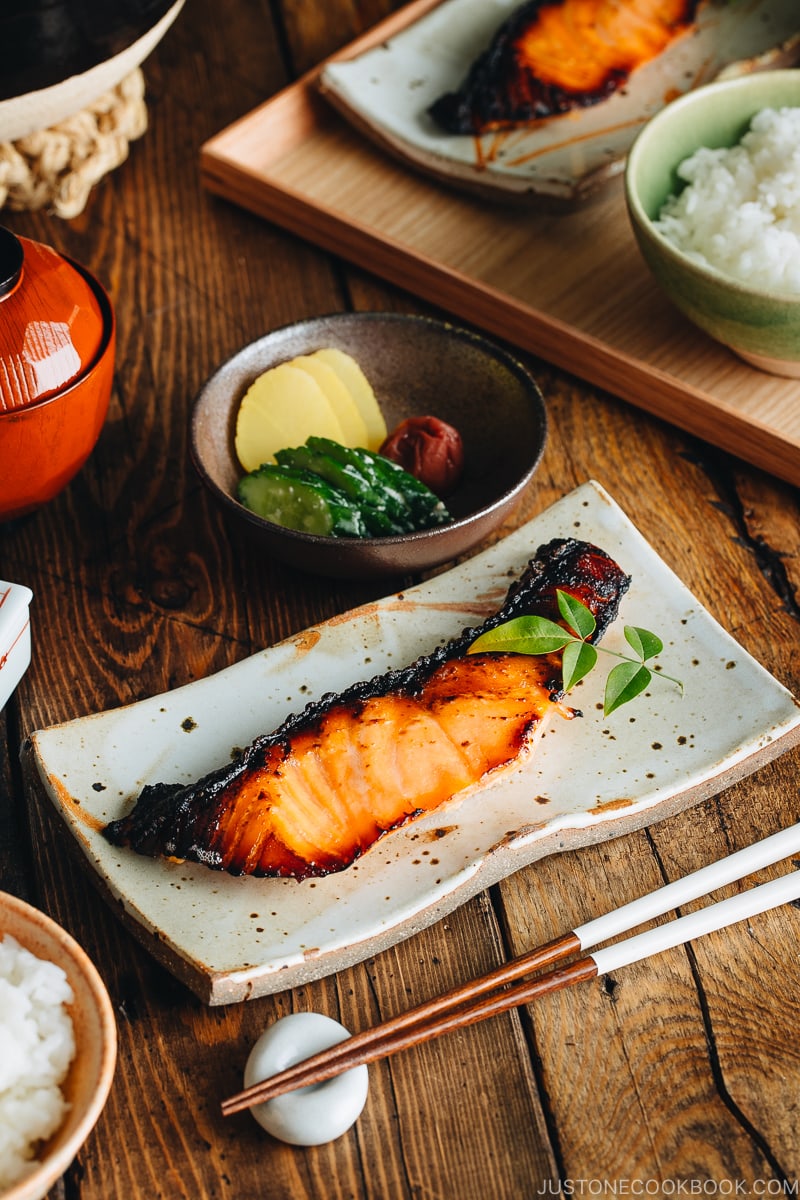
What To Serve With Salmon Kasuzuke
We usually serve grilled fish like this recipe with rice, miso soup, and small side dishes. Here are some dishes that go well with Salmon Kasuzuke:
Rice
- Steamed Rice cooked in a rice cooker, pot on the stove, Instant Pot, or donabe
- Takikomi Gohan cooked in a rice cooker or Instant Pot
- Bamboo Shoots Rice
Miso Soup
- Miso Soup
- Vegetable Miso Soup
- Tonjiru (Pork and Vegetable Miso Soup)
Side Dishes (choose 2–3)
- Kinpira Gobo
- Simmered Taro
- Spinach Gomaae
- Agedashi Tofu
- Hijiki Salad
- Simmered Kabocha
- Okra Ohitashi
- Simmered Kiriboshi Daikon
- Sunomono (Cucumber Salad)
Pickles
If you’re interested in serving fish the Japanese way, you can read Plan a Japanese Meal: One Soup Three Dishes “Ichiju Sansai”.
I hope you enjoy this time-honored, simple yet delicious salmon recipe!
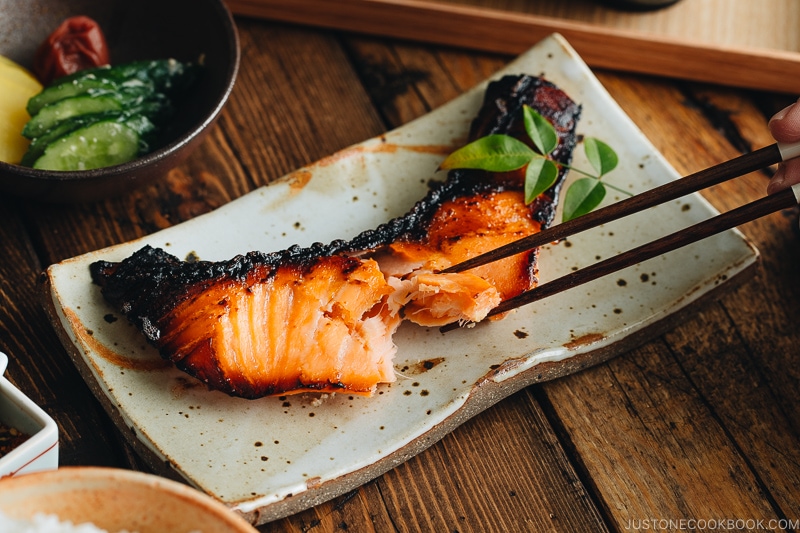
Wish to learn more about Japanese cooking? Sign up for our free newsletter to receive cooking tips & recipe updates! And stay in touch with me on Facebook, Pinterest, YouTube, and Instagram.
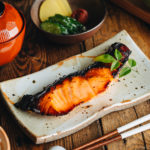
Salmon Kasuzuke (Sake Lees Marinated Salmon)
Ingredients
- 4 skin-on salmon fillets (1 lb, 454 g; I use salmon from a Japanese grocery store, so it‘s a thinner cut)
- 2 tsp Diamond Crystal kosher salt (2% salt of salmon weight, 9 g)
- Homemade Kasudoko (sake lees marinade; see my Kasuzuke (Sake Lees Pickling) post for how to make it at home)
Instructions
- Before You Start: Please note that this recipe has a marination time of 6–24 hours.
- Gather all the ingredients. For the ingredient list, instructions, and step-by-step photos of how to make homemade kasudoko (sake lees marinade), see my Kasuzuke (Sake Lees Pickling) recipe post.
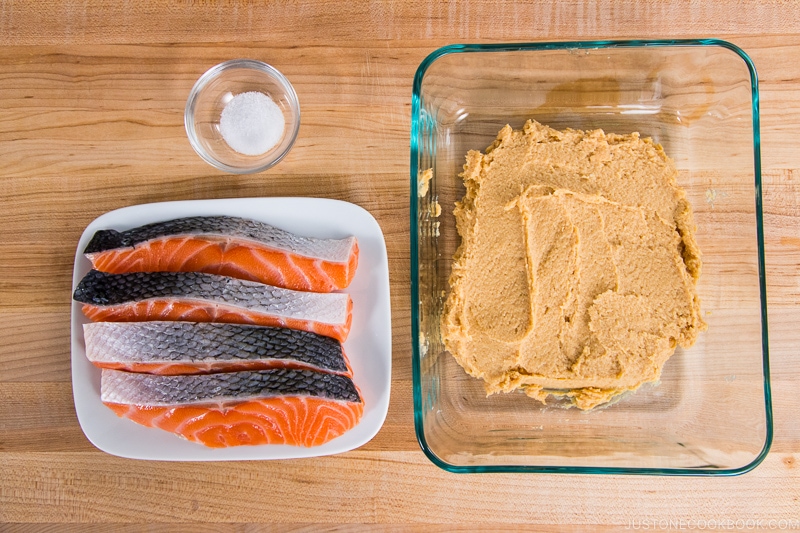
- Sprinkle 2 tsp Diamond Crystal kosher salt on both sides of 4 skin-on salmon fillets and set aside for 30 minutes.
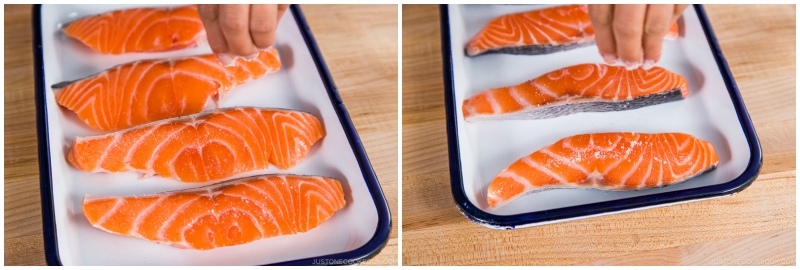
- Remove the excess moisture from the salmon with a paper towel.
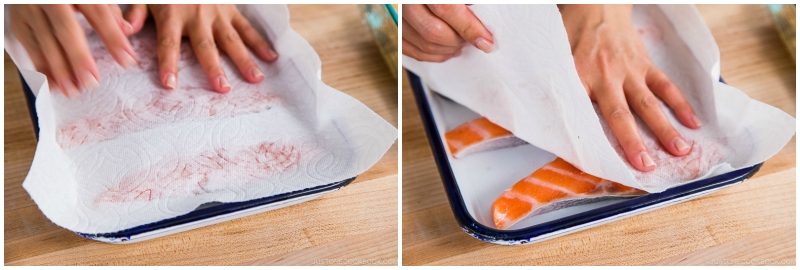
- Place the salmon in the Homemade Kasudoko. Cover all sides of the salmon completely.
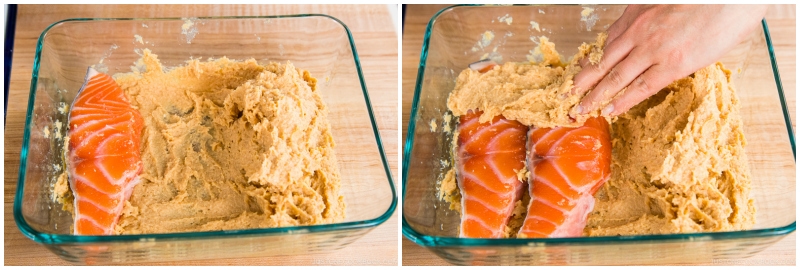
- Place in the refrigerator and marinate the salmon for 6–24 hours.
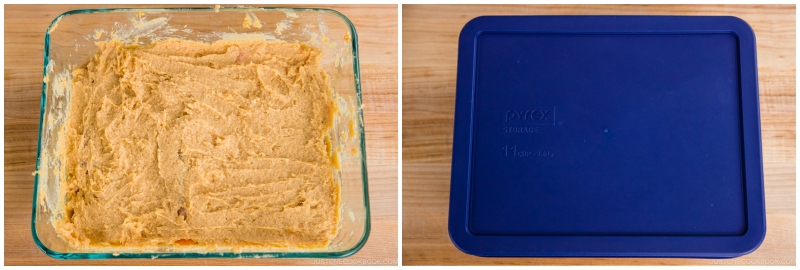
To Prepare for Cooking
- Take out the salmon and wipe off as much of the kasudoko as possible. Some recipes may say to rinse off the marinade with water, but I do my best to remove it by hand or a paper towel.
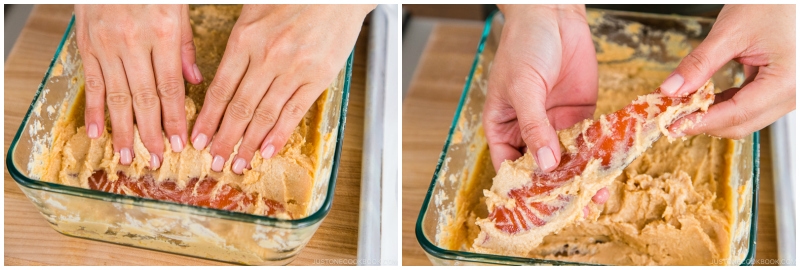
- Place the salmon skin side up on top of a baking sheet lined with parchment paper.
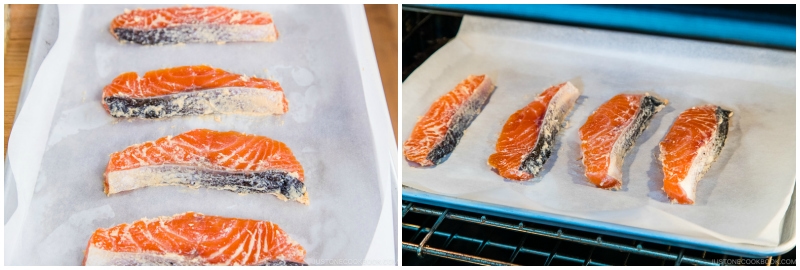
To Broil (Recommended)
- Preheat the broiler* for 5 minutes with a rack placed in the center of the oven about 6 inches (15 cm) away from the top heating element. When broiling, you don‘t control the temperature in the oven; instead, you control the distance between the broiler and the surface of the food. It‘s similar to using hotter and cooler zones on your grill. *Broiler settings: Low (450ºF/232ºC), Medium (500ºF/260ºC), and High (550ºF/288ºC). I usually use Medium (6 inches away) or High (8 inches away).
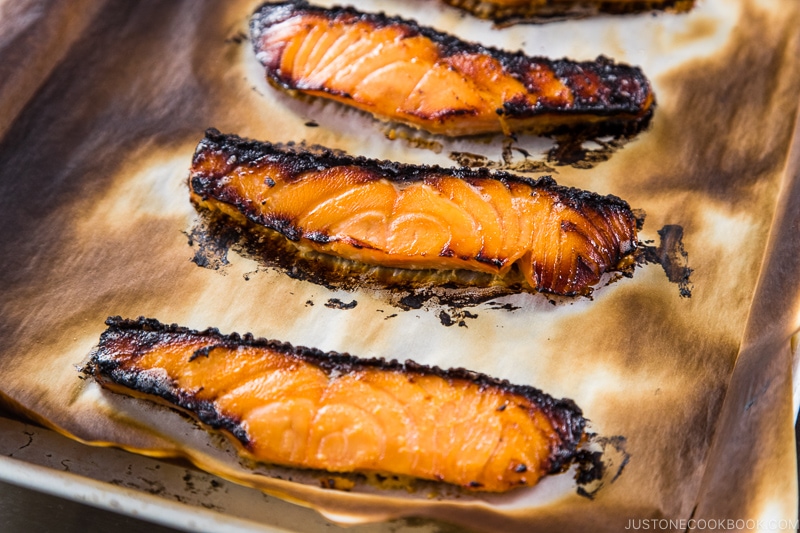
- Broil the salmon at Medium or High for 8–10 minutes until the edges are browned and caramelized. Please remember the cooking time varies depending on the thickness of the fish and the distance between the broiler and the food. You do not need to flip it.
To Bake (Optional)
- Preheat the oven to 425°F/218ºC with a rack placed in the middle. For a convection oven, reduce cooking temperature by 25ºF (15ºC). Bake the salmon on parchment paper for 10–12 minutes.
To Serve
- Transfer to individual plates and serve immediately.
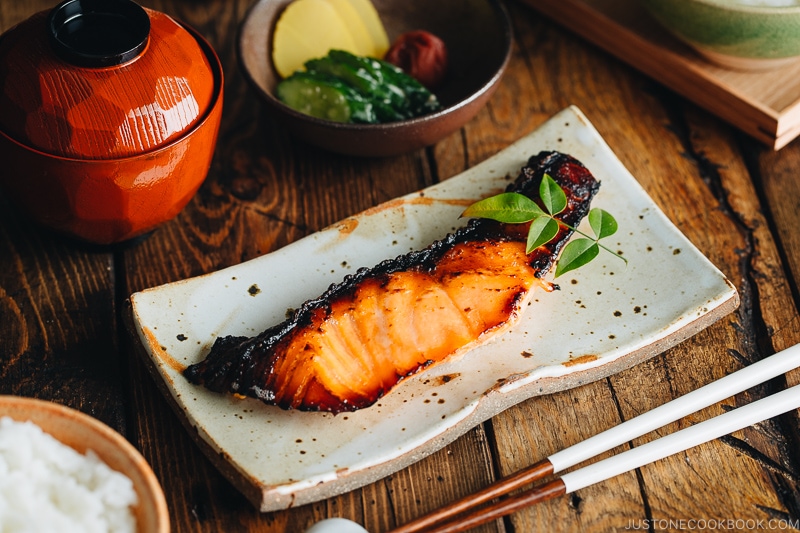
What To Do with the Leftover Kasudoko
- You can reuse kasudoko for up to 6 months. If it gets watery, I recommend discarding it. Make sure to refrigerate and reuse it for salmon or another type of fish. I do not like to mix with meat. You can NEVER use this kasudoko to pickle vegetables or any food that you eat raw.

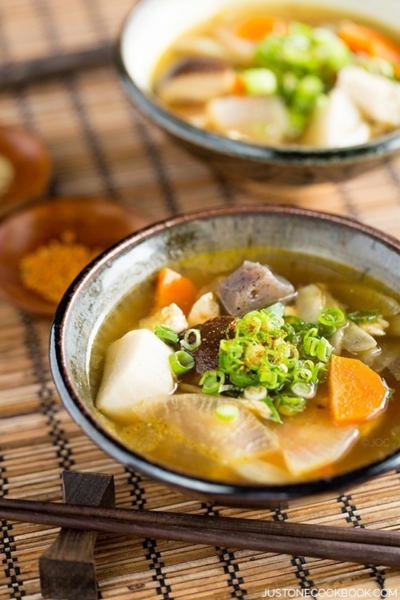
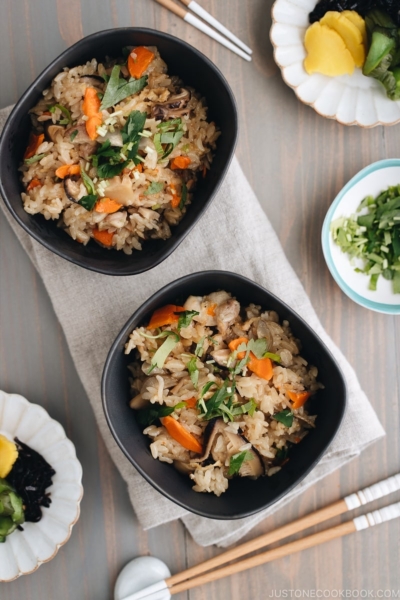
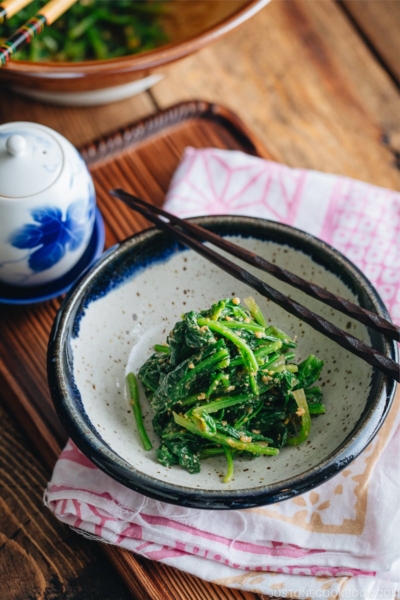
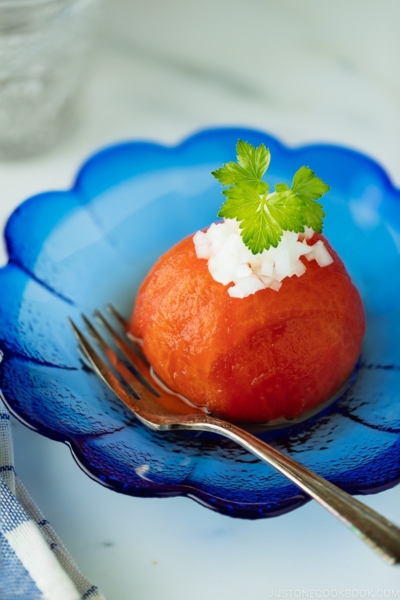




Did you use shiro miso here? My kasu turned out so white and my mothers was often that brown color as well. I’m wondering if I should have put in much more miso but I followed your recipe that was linked.
Hello, Momoko. Thank you for trying Nami’s recipe.
Yes. Nami used white miso. Kasudoko is often made with white (Shiro) miso, but you can season sake lees with whichever miso you have in the fridge.
We hope this helps!
Thanks for this tasty recipe, one of many on your website! I have had good success wrapping the fish in cheesecloth, so that when they come out of the kasudoko, very little sticks to the flesh and no wiping is necessary. You can use the cheesecloth again many times, too.
Hi Chris! Thank you very much for trying Nami’s recipe and sharing your cooking experience/tip with us!🙂
This was by far the most delicious salmon we’ve ever had. We bought the kasu marinade and now we have many meals of salmon kasuzuke 🙂
Hi Kirti! Yay! Thank you very much for trying this recipe and for your kind feedback!
Hi! Thank you for this recipe. I tried making it with him-Mirin instead of sugar/sake, as you suggested in your other Kasuzuke recipe. I had a piece of salmon sit in the marinade for 24 hours, and when I cooked it, it was pretty strong in alcohol-y smell. Is that a warning that I may have put in too much hon-Mirin? Can I salvage my Kasuzuke or do better in my next marinade (perhaps less time?) to make the fish not so full of alcoholic taste? Thank you for bringing such good recipes in a cuisine I really hope to learn more of.
Hi Joe! It does not matter if you use hon-mirin or sake + sugar in this recipe as sake lees (sakekasu) is the source of the sake taste/smell. This divides people who enjoy it and don’t. To me, it was a very acquired taste and never liked it growing up. When you open the sake lees package, you smelled the strong sake/alcohol, right? You can maybe use a small amount of kasuzuke instead of marinating the fish surrounded by a lot of kasuzuke. That might help… like, just spoonful and spread around? Oh and try less time too. It’s definitely an acquired taste, like Amazake (a drink also using sake lees). 🙂
Are there other types of fish that work great with this preparation? I too am in the Bay Area so have access to the same fish as you. Would this be good maybe with halibut? Or black cod (butterfish?)? …other fish or seafood? And then … what about chicken fillets? Just wondering… Thank you Nami!
Hi Lynn! Kasuzuke can be used for any fish! Sure, halibut works, cod (butterfish) are GREAT! We use it for vegetables and chicken too! 🙂
The post mentions that the salmon can be grilled or broiled. If you grill it would you need to oil the grates or would you recommend grilling on a tinfoil base?
Hi Miriam! Thank you for bringing this to my attention. I meant grilling on the stovetop using a grill pan (heat source is bottom) or broiling in the oven (heat source is top). I don’t recommend BBQ grill as the fish can be flaky and break into pieces directly on top. Putting on aluminum foil should work though… 🙂
I’ve not seen salmon fillets at the supermarket here—only salmon steaks. What is the name of this particular cut of salmon, in Japanese? I’ll try asking the Japanese fishmonger here if he can cut it for me this way.
Hi Angela! We say “Kirimi” which means fillet. So there is no specific name for it… Here I found a website in Japanese that has images so you can see how we cut:
https://ws-plan.com/gyokairui/sake-kirimi.html
i would love to try this! is it sake lees typically available at a japanese market?
Hi Jenny! I find one in my local Japanese grocery store (Nijiya in San Mateo), but it might be a good idea to call ahead to check if you have to drive for a long time to get there. 🙂
It would be helpful if you would consider doing a series similar to Rachel Rays where she prepared a lust if “staples” to keep in hand, and the set of ingredients to purchase for that weeks or so of meals. Lots of reuse, little waste. We “gaijin” love your meals, but sometimes have to buy way too much just to do one meal. You’re in production mode, but we’re in meal mode. Think of three days of menus that share ingredients.
Love your recipes and blog.
Hi John! I’ve thought of this many times too… kind of like a meal plan, but a real meal plan where everyone follows the menu exactly. From the feedback I received from my readers, I also know that everyone wants a plan that works for them… If I do for a family of 4, people would ask me to create for 2, and I also get what if I don’t eat this ingredient and that… and I felt it’s very overwhelming to share a meal/ingredients plan… because if it’s for 4 people, and if you want only 2, you have to calcurate which day I use that ingredient and then adjust the amount. I can’t explain well, but it gets complicated when people try to “adjust” instead of “follow” exactly… so I am kind of discouraged to do this to avoid a crazy number of comments… But I really thought of doing this because if someone can follow exactly and have no preference in ingredient/food, it’s very helpful.